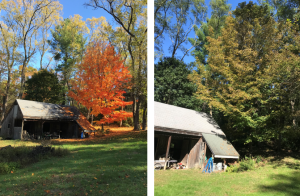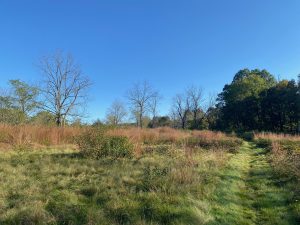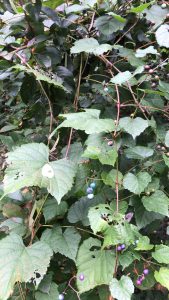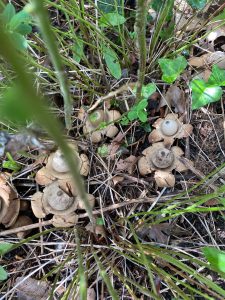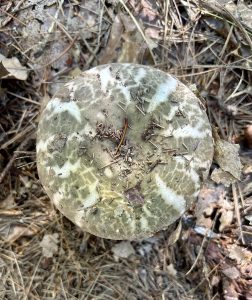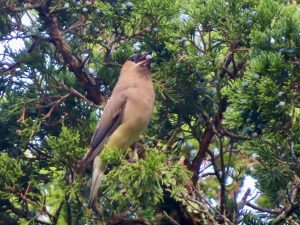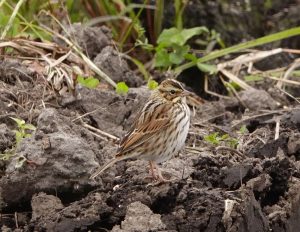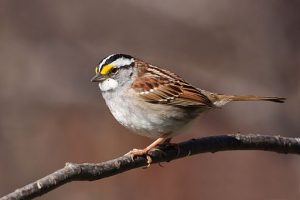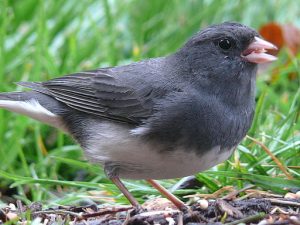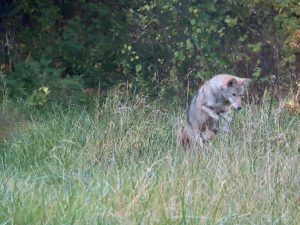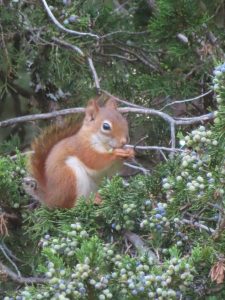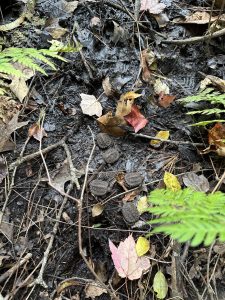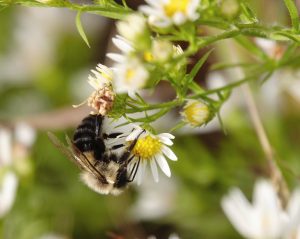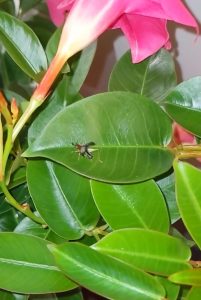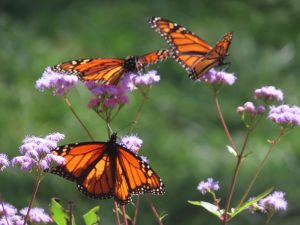Written by Gwyn Loud for the Lincoln Land Conservation Trust. She welcomes your sightings and questions at 781-259-8690 or gwynloud555@gmail.com
October arrived feeling like summer, with temperatures up in the 80s during the first week. Rainfall in MetroWest for September was 4.62” exceeding the September average of 3.77”, making this the third month in a row where precipitation exceeded its monthly average. Rainy weekends were the pattern. Fall foliage seems both late and muted this year. Although there are spots of bright color, some trees, probably due to excessive rain and fungus, have leaves which have turned brown and dropped. Homeowners are encouraged to “leave the leaves” rather than having them blown or taken away because the leaves enrich the soil as they decompose and provide habitat for small organisms over the winter.
The world of plants is rich with seeds, berries and nuts at this season, providing important food for birds and mammals. It is always good when gardeners leave stems with seed heads standing, as birds like the seeds and various insects overwinter in the stems. Unfortunately, I discovered a new invasive on my property, porcelain-berry. So far it is mostly in southeastern MA and along the coast, and at my house! Its leaves are like grape leaves, the berries a pretty blue color right now, and I read that it can grow 10-15 feet in a year and smother the plants it covers.
I have been watching robins and other birds feeding on the blue berries of Virginia creeper and bluebirds eating berries in my flowering crab trees. Carol Roede photographed cedar waxwings eating the berry-like cones on junipers and a blue jay gathering acorns. As written in an article from the Westborough Community Land Trust, “Blue jays prefer small acorns and can carry 5 at a time. How do they manage that? They fly with three in their throat, one in their mouth, and one in their bill. A blue jay will travel to a chosen spot on the ground, up to a mile and a half away from the oak tree. There it dumps the acorns in a pile and proceeds to bury them, one by one, in various places within about 10 feet of the pile. A single blue jay may hide 3,000 – 5,000 nuts in a season.” The jays do quite a good job of remembering where the acorns were hidden.
Avian migration continues, with various birds passing through on their way south. My hummingbird feeder is washed and put away for the winter; ruby-throated hummingbirds departed during the last week of September if not before. Species of migrating warblers observed recently include Northern parula, palm, pine, blackpoll, yellow-rumped, Nashville, black-throated green, and common yellowthroat. October is often considered sparrow month by birders; if you see flocks of “little brown jobs” they could be chipping sparrows or Savannah sparrows. Swamp sparrows have been in the mix and an uncommon one, a clay-colored sparrow was spotted at Drumlin Farm. White-throated sparrows have just arrived from the north and they will remain here for the winter, along with dark-eyed juncos which have also just returned. Other recent notable bird sightings include a blue-gray gnatcatcher, Eastern Towhees, ruby-crowned and golden-crowned kinglets, sharp-shinned hawks, and a Northern harrier.
Those who feed birds are advised set up feeders by the end of the month to make sure the birds put your “restaurant ‘ on their route. A citizen-science project sponsored by Cornell called Project Feeder Watch is an easy and enjoyable way to both observe birds at your feeder and contribute to national data about avian populations. See link below for more information on how to join.
Our local mammals are busily preparing for winter, caching supplies of food and, in some cases growing thicker fur. A Bedford Rd resident was surprised to see a blond woodchuck! Woodchucks are true hibernators and will spend the winter in a den, with their body temperature dropping from 99°F to 40°F, and their heartbeat from 100 beats per minute to 4 beats per minute. They will emerge, ready to eat again, in early spring- maybe even on Groundhog Day. Our smallest mammals such as mice, voles, and shrews are active all winter, and chipmunks can be considered nappers. Chipmunks make extensive tunnels about two feet below the ground’s surface, with designated chambers for storing food, defecating, sleeping, and giving birth. From November to March they are underground in a torpid state, with lower temperature and heart rate, but they wake very few days to eat from their stored food. At this season I see many chipmunks dashing over my lawn, cheek pouches ballooning out as they disappear down holes with their collected winter meals.
Residents have reported seeing bobcats in several parts of town as well as muskrats, coyotes, and beavers. Carol Roede caught bucks sparring on a trail cam and wrote, “ Not exactly an even match, but they didn’t seem all that serious about it. They were in that area for about 15 minutes, sometimes just standing there or sniffing each other, sometimes facing off. Does are around too, sometimes grooming each other.” On Hillside Rd. a fisher passed four feet from a sliding door, stopping to give a “cold calculating look”. It returned the next day, without “the look.” Each evening Taps is played at Hanscom Air Force Base and coyotes can be heard howling in response. Are coyotes musical? Patriotic? See video and audio links below.
Snapping turtles hatched in September and several people in different parts of town watched the young make their way towards a pond or swamp. It is a perilous journey, especially if the baby turtles have to cross roads, and the soft-shelled babies can also be eaten by predators. One observer counted nineteen babies, which is a high survival rate. Research shows that only 5% of eggs laid will hatch, and that only 1% will survive to maturity (8-10 years).
Bees have been busy on fall flowers such as asters, goldenrod, and Joe-Pye weed. Observing bees on asters in the Umbrello fields, Norman Levey explained, “These are male impatiens bumble bees foraging for nectar. These are the last for the season and by far the greater number are wandering mustachioed males looking for fat queens, which are harder to find.” Two people wrote to me about witnessing flocks of birds apparently feeding on swarms of small flying insects which must have just hatched. We are still hearing crickets singing, and a Weston Rd. resident discovered a red-headed bush cricket (aka handsome trig) on a house plant. Norm Levey identified it and wrote, “They moved to our area the first decade of this century; I noticed one around 2007. They seem to climb buildings, hitch rides on cars, get on potted plants. The males make a rattling metallic call.”
Monarch butterflies are making their way to the mountains of Mexico to spend the winter. An interesting article by Rachel Mirus in The Outside Story describes research to determine if “redder is better” when it comes to migratory strength for the monarchs. A researcher at the University of Georgia, Andy Davis, found that redder individuals of any season were better flyers. “He doesn’t think the redder color is connected to aerodynamics, but rather that it’s an indicator of health. Redder butterflies, in addition to being stronger flyers, live longer, have more fat reserves, and attract more mates. Exactly how and why some butterflies are redder and stronger isn’t understood. The brick-red shades could indicate that some butterflies ate more as caterpillars, or that they are more metabolically efficient and can therefore make more pigment for their wings.” Davis was also co-author of an article describing how long-distance migration selects for larger white spots on monarch butterfly wings. Monarchs are now classified as Endangered Species by the International Union for the Conservation of Nature and are scheduled to be listed in 2024 as Endangered in the US.
Looking skyward, the Orionid meteor shower will peak about 10 PM on October 22. Check the link below for details about how best to watch the show. The full moon will rise on October 28 and is called by astronomers the Hunter’s Moon, a name taken from the Algonquin tribe. Other Native American tribes have different names for the October full moon: to the Taos it is the Corn Ripe Moon, to the Laguna, the Ripe Corn Moon and to the Nez Perce the Falling Leaves Moon.
Last but not least, I am proud that Governor Maura Healy was the first governor in the country to set forth goals for biodiversity in the Commonwealth, realizing that without biodiversity we will not have heathy ecosystems. Her executive order, given on September 21 as part of National Climate Week, directs the state to develop biodiversity goals for 2030, 2040, and 2050.
Links


